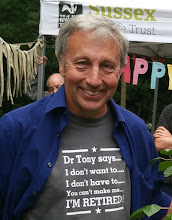BBC2’s Newsnight programme on
28th May had a fascinating discussion about the idea of
“re-wilding”. I haven’t read it yet, but
this comes from George Monbiot’s book “Feral”, and it looks like it will give a
welcome boost to a public discussion on the “nature” part of nature
conservation.
Re-wilding is something I've been fascinated about for many years.
The whole idea of “managing nature” seems an oxymoron – why should we
have to look after nature when, by definition, nature is something outside the
human so should function for itself? I
used to give talks entitled “if it isn't bust why fix it?” – alluding to the
idea that nature is not something that inherently needs tending by humans. And I've represented the Trusts in meetings
of the Wild Britain Initiative on occasions.
Also in Sussex we
have established large non-intervention areas on our Reserves where nature is
given more of a free hand and we work with one landowner in particular who is
experimenting with naturalistic grazing in a large rewilding project. So the Wildlife Trusts are not strangers to
the idea.
It is, however, also true
that we live in a “cultural landscape”, where the value of our landscape says
something about the interaction between people and nature. For thousands of years people in Britain
So we apparently have two
opposing philosophies: one about nature being a system outside the human and so
functioning for itself, the other about a landscape formed from the
interactions of people and nature so needing continued management.
But these are not opposites
in terms of having one or the other. Unfortunately
the Newsnight discussion did develop towards an all-or-nothing debate but this
can be avoided if you see these approaches as being at two ends of a spectrum,
rather than opposites. However, (and
here’s the surprise) neither end of the spectrum actually exists!
Nowhere in the UK
Alternatively, however,
nowhere is truly artificial either. Even
a field of wheat – managed, sprayed, fertilised and cultivated – is not just
the product of human hands. Humans did
not create the soil and soil organisms that are so essential to the crop, nor
did we plant all the weeds, introduce the insects or create the water cycle and
atmosphere that the crop lives within. So
even “artificial” systems depend entirely on nature. Much of our landscape, however, is far nearer
the artificial than it is the natural.
So, parts of our landscape could
be said to fit at different points along this spectrum. The idea of moving significant areas further
along the spectrum towards the natural is an extremely valuable concept and one
that the Wildlife Trusts have promoted for years.
To promote the wild we need a
deep understanding of what this means in practice. Wild nature should be
one in which all the ecological processes are working – all forms of growth,
decay, and in particular natural disturbance. If some of this is absent
then the result would be neglect, not wild nature. So, to promote the
wild, we need to understand natural disturbance – this includes storms,
erosion, fire (sometimes), but particularly grazing/browsing and the effect of
predators. Miss out these processes and you do not end up with wild, you
just end up with another human artefact.
It is not possible to have
the full range of ecological processes in the UK
There are two answers to this
shortcoming. One is to endeavour to put
back those ecological processes – and I am completely with George Monbiot on
this. We can re-wild river systems, and
the Wildlife Trusts now have several examples.
We can increase the size of our reserves (see The Great Fen Project),
and allow storms, erosion and other disturbances to take their natural course,
and again we have several examples of this.
We can also put back some semi-wild grazing animals that are often
absent (see the Knepp project). It is
perfectly reasonable to aim to reduce management intervention and re-establish
natural processes. We can sometimes get
nearer to the wild in a spectrum, even though it may not be possible to
actually get there (and in practice we do not know what wild looks like in the
northern temperate zone anyway).
Furthermore, we have far too few examples in the UK
The other answer is human
intervention. Some management
intervention can be good as it effectively re-establishes the diversity that is
lost through a lack of natural processes. Woods are too small to hold the
full cycle of growth, disturbance and decay; so coppicing (for example) puts
back a disturbance cycle. Grazing can be
put back in ungrazed areas and even cultivation and soil disturbance just
mimics what wild boar would have done naturally. In practice the vast majority of the English
landscape will end up in this category, and rightly so – the continued positive
interaction between people and nature in a cultural landscape.
There is space in the UK

No comments:
Post a Comment